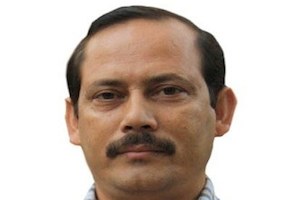As the year 2014 is about to wrap-up, India has improved on its record of protecting journalists, this time with only two journalists’ killings, writes our guest columnist Nava Thakuria (pictured left).
The largest democracy of the globe also supports a robust media fraternity involving a huge number of media persons, many of whom perform their duties with unprecedented threats and limitations, but with all their commitments to the medium.
Unlike 2013, when the populous country lost more than ten journalists in twelve months, the present year is expected to culminate with the casualties of two working journalists. The first murder of journalists this year took place in Odisha (earlier Orissa) and second (also the last one till today) incident was reported from Andhra Pradesh.
The country’s immediate neighbours like Pakistan (Irshad Mastoi, Abdul Rasool), Bangladesh (Sadrul Alam Nipul) and Burma (Aung Kyaw Naing) also lost their journalists to assailants, though Bhutan, Nepal, Tibet (China), Sri Lanka, Maldives have not reported any incident of journalist killing this year till the second week of December.
India woke-up to the persisting threats to journalism this year with the brutal murder of Tarun Kumar Acharya (35 years old), a young repoter of Ganjam district in Odisha. Acharya used to work for a
regional news channel (Kanak Television) and contributed regularly for Oriya newspaper Dainik Sangbad.
The young reporter was found with his throat slit open by a sharp knife at Khallikote 130 km away from Bhubaneswar on the night of May 27. A few days before his murder, Acharya had prepared a series of
stories relating to the local cashew-nut processing factories deploying children as regular workers. Moreover, he remained vocal against some powerful individuals in his locality, who often made
social nuisances.
On the fateful night, he was targeted by goons on his way home riding on his two-wheeler. Acharya died on the spot and his body was later recovered by local villagers with severe injuries on his neck and
head. The Odisha police started investigating the case in a low pace, only to receive brickbats from the journalist fraternity in particular and civil society groups in general.
Finally the Odisha authority succeeded in nabbing two perpetrators namely Shyamsundar Prusty, who owns a cashew processing plant in Khallikote and Ramesh Reddy, a small time businessman from Berhampur relating to the crime. According to the local police, Prusty developed a grudge against Acharya after he reported about the child labour practices in the cashew-nut processing factory and took help of Reddy in killing the reporter.
Acharya’s murder was unanimously condemned by Orissa Union of Journalists, Berhampur Press Club, Media Unity for Freedom of Press, Journalists Coordination Committee, Journalists’ Forum Assam, National Union of Journalists etc and demanded adequate compensations to Acharya’s young widow, a minor girl and old parents. National Human Rights Commission (of India) also registered a case (Regn. No. 2605/18/5/2014) regarding the murder.
The second victim, MVN Shankar (53) was based at Chilakaluripet of Guntur district in Andhra Pradesh. A senior journalist working with Andhra Prabha, a popular Telugu daily published from Hyderabad, Shankar was attacked by unknown assailants with iron rods and sticks on the night of November 25 in front of his residence. He was moved to Guntur hospital with severe head injuries where Shankar succumbed to the injuries next day.
Shankar, who left behind his wife, a daughter and a host of relatives, prepared a number of news-stories relating to the kerosene mafia, which used to sell the domestic fuel, supplied through the
public distribution system, in the black market. A brave media person, who raised voices for due benefits to fellow journalists, Shankar even lodged a complaint in the Guntur police station asking actions against the corrupt food-item dealers.
The local journalist bodies including Andhra Pradesh Union of Working Journalists and Andhra Pradesh Newspaper Employees Federation organized protest rallies demanding punishments for the perpetrators of the crime. Lately the Indian Journalist Union and International Federation of Journalists cane out with statements condemning the murder and demanding justice to the deceased journalist and his family. But no arrest was made even after a fortnight of the murder.
According to the Reporters Without Borders (RSF), a Paris based media rights body, 63 journalists have been killed in 2014 till December second week where the motives have been cleared that the victims were targeted because of his/her activities as a journalist. The deadliest countries include Syria (12), Palestine (7), Ukraine (6), Iraq(4), Libya (4), Philippines (3), Mexico (3), Afghanistan (3), Central
African Republic (2), Paraguay (2), Somalia (2), Brazil (2), Colombia (2), Russia (1), Somalia (1), Egypt (1) etc.
Compare to 2013, India has shown a better statistics this year as it has witnessed the slaughtering of two journalists till today. The populous country lost 11 journalists to the perpetrators including
three media employees (Sujit Bhattacharya, Ranjit Chowdhury and Balaram Ghosh of Tripura) in northeast India. The previous year (2012), five journalists including one from Assam (Raihanul Nayum) and another from Manipur (Nanao Singh) were killed.
Pictured below are the two journalists who lost their lives this year. Rest in Peace.

